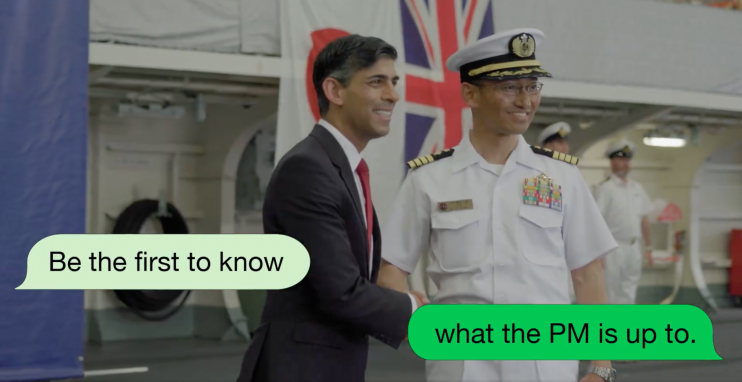The real reason Rishi Sunak spends £3,500 on Facebook ads

In a little noticed coup, the Conservatives quietly raised the campaign spending limit by 80 per cent – money that is bound to be funnelled into online ad campaigns, writes Lucy Kenningham
If you haven’t been targeted with political ads already, be prepared. Messers Rishi Sunak and Keir Starmer will be popping up to invade your feed imminently, and more tenaciously than ever before.
That’s down to two things. One, social media advertising has leapfrogged over billboard erection and leafleting to become the modus operandi of political campaigning – it is predicted to account for a third of all campaign spending this election. Two, the campaign spending cap was raised by 80 per cent in November last year. This limit applies to party spending during the 365 days before polling day – and applies retrospectively in case of a snap election.
This staggering increase – upping the limit from £19.5m to £35m – was not voted on by MPs. Since 2010, the government has had a statutory duty to raise the limit in line with inflation – or explain why it’s not doing so. The UK’s election watchdog, the Electoral Commission, said it had “not seen evidence” to support the changes. And whilst an 80 per cent increase is in line with inflation since 2000, it is certainly rather suspicious timing. Inflation has affected some areas more than others; digital ads are still cheap – unlike the price of a first class stamp or the cost of a bottle of olive oil.
Liberal Democrat Peer Lord Chris Rennard accused the Tories of a “desperate” bid to gain an advantage in a terrible climate for their side, pointing out that no party has ever actually reached the limit as it stands. In 2019, the Conservatives spent around £16m.
Smaller parties which cannot afford to keep up are keen critics of the higher spending limits. Of all Facebook and Instagram spending this year, 52 per cent has been spent by Conservatives and 45 per cent by Labour – but just 1.6 per cent by Lib Dems, 0.5 per cent by the Greens and 0.2 per cent by Reform.
The Electoral Reform Association said: “Rather than fix the worrying loopholes that already exist in our system… the government are just increasing the amount that can flood in. This decision to raise the cap shows we are moving in the wrong direction. We need more transparency and stronger regulation.”
This year so far, both parties have spent a combined £700,000, or thereabouts. This is compared to £67,000 for the same period last year.
All this money is coming in at a time when digital ads are thriving like never before. “Political adverts on social media are cheaper and more targeted than any other advertising in history,” explains the website Who Targets Me, which is dedicated to exposing political adverts.
Targeted ads sound like a devilishly evil tool for campaigners. Yet it’s not quite so simple. “There is a diminishing return because the more layers of targeting you put on the advertising, the more expensive the ad is,” Benedict Pringle, who runs politicsadvertising.co.uk, said. So you may be able to get extremely specific with your targeting – for example in 2019 the Liberal Democrats were shown to have directed ads at people interested in ‘Barack Obama’ and ‘The Economist’ – but it’ll cost you more to send such tailored campaigns.
Conversely, the Tories spent less per engagement in the last election by bashing out ads with a simple message – Get Brexit Done – to anyone and everyone.
At the moment, the Conservatives appear to be continuing this rather unscrupulous, yet effective, approach. Who Targets You notes the “lack of specific location targeting” in the current Tory campaign, which is – in a strategy that seems oblivious to any publicly released polling – centred around Rishi Sunak’s personal brand.
“Rishi Sunak’s digital ad strategy is pretty simple at the moment. He spends £3,500 a day on ads asking people to like his Facebook page. All other ads are paused,” the site explains.
Starmer apparently runs similar ads (your columnist has not been subject to either of them) but “his page grows about half as fast as Sunak’s… because he spends less money on this tactic” – crucially, “almost all of Starmer’s ads are postcode targeted”.
It’s undeniable that these ads will have an impact. As Sam Jeffers, who runs Who Targets Me, says: “Ads never get tired or need pizza. They don’t care if it’s raining”. With a bulging new wallet to spend with, both parties will be commissioning irritating videos like never before. While many of us will simply swipe them away, this big shift could have serious effects on our democracy –eclipsing smaller parties and muddying the digital waters, already swimming with deep fakes and other nasty detritus. Brace yourselves.